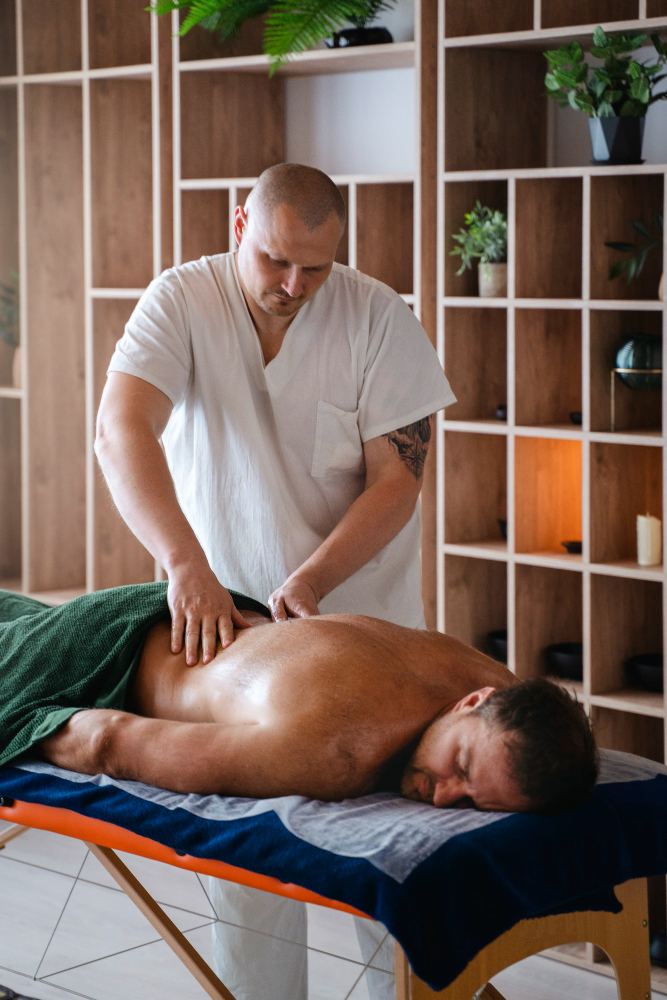
Kati Vasti (also spelled Kati Basti) is a highly specialized and effective Ayurvedic treatment primarily for conditions affecting the lower back. It falls under the category of Bahya Vasti (external oleation therapy), where medicated oil is retained over a specific area of the body.
The term “Kati” refers to the lower back or lumbar region, and “Vasti” (or Basti) means “to hold” or “a container/reservoir.” So, Kati Vasti literally means holding medicated oil over the lower back.
How is Kati Vasti Performed? (Procedure)
- Preparation of the Dough Ring: A thick, pliable dough is prepared, usually from black gram flour (Urad Dal) or wheat flour, mixed with water. This dough is then shaped into a ring or dam. The size and shape of the ring are customized to fit comfortably over the specific painful or affected area of the lower back.
- Patient Positioning: The patient lies face down (prone position) on a comfortable Droni (Ayurvedic treatment table) or a massage table.
- Placement of the Dough Ring: The dough ring is carefully placed on the lower back, encircling the area of concern (e.g., lumbar spine, sacral region). The edges of the dough are gently pressed and sealed to the skin to create a leak-proof reservoir.
- Warming the Oil: A specific medicated herbal oil (chosen by the Ayurvedic physician based on the patient’s condition and dosha imbalance) is warmed to a comfortable temperature. Examples of oils include Mahanarayana Taila, Ksheerabala Taila, Dhanwantaram Taila, Nirgundi Taila, Bala Ashwagandha Taila, or Sahacharadi Taila.
- Pouring the Oil: The warm medicated oil is slowly and carefully poured into the dough reservoir until it fills the entire well.
- Retention and Temperature Maintenance: The oil is retained in the reservoir for a stipulated period, typically 30 to 45 minutes. During this time, the therapists continuously monitor the oil’s temperature. As the oil cools, a portion of it is carefully removed and replaced with freshly warmed oil to maintain a consistent therapeutic temperature.
- Post-Procedure: After the prescribed duration, the oil is gently removed from the reservoir using cotton or by tilting the ring. The dough ring is then carefully detached. A light, gentle massage (Abhyanga) may be performed on the treated area. The area is then wiped clean, and sometimes a warm towel fomentation (Swedana) is applied. The patient is advised to rest for a short while.
Mechanism of Action:
Kati Vasti works through a combination of effects:
- Oleation (Snehana): The warm medicated oil deeply penetrates the skin, nourishing the underlying tissues, muscles, ligaments, bones, and nerves of the lumbar region. This provides lubrication and reduces dryness and stiffness (pacifying Vata).
- Fomentation (Swedana): The sustained warmth from the oil induces localized sweating, which helps to relax muscles, improve blood circulation, and facilitate the removal of metabolic waste products and toxins (Ama) from the affected area.
- Pharmacological Action of Herbs: The active compounds from the herbs infused in the oil exert their specific therapeutic effects, such as anti-inflammatory, analgesic (pain-relieving), muscle relaxant, and rejuvenating properties.
- Increased Blood Circulation: The localized heat and oil application enhance blood flow to the lower back, delivering essential nutrients and oxygen to the damaged tissues, promoting healing and recovery.
- Sedative Effect: The warmth and the medicinal properties of the oil, combined with the relaxing nature of the treatment, can have a sedative effect on the nerves, reducing pain sensation and muscle spasms.
Key Benefits of Kati Vasti:
Kati Vasti is highly beneficial for a wide range of lower back and spinal conditions, predominantly those associated with Vata imbalance:
- Chronic Lower Back Pain (Lumbago): Effectively reduces pain and discomfort, whether acute or chronic.
- Lumbar Spondylosis: Helps alleviate stiffness, pain, and discomfort associated with degenerative changes in the lumbar spine.
- Sciatica: Relieves radiating pain, numbness, and tingling sensations down the legs by reducing nerve irritation and compression.
- Disc Problems: Beneficial for conditions like disc herniation (slipped disc), disc bulge, and degenerative disc disease by reducing pressure on spinal nerves, inflammation, and supporting disc health.
- Muscle Spasms and Stiffness: Relaxes tight muscles, reduces muscle cramps and spasticity in the lower back.
- Sacroiliac Joint Dysfunction: Alleviates pain and improves mobility in the SI joint.
- Coccydynia: Reduces pain in the tailbone area.
- Osteoarthritis of the Hip: Can help by supporting the surrounding lumbar region.
- Strengthens and Nourishes: Strengthens the bones, muscles, ligaments, and nerves of the lumbar region, improving overall spinal health and flexibility.
- Improves Mobility and Flexibility: By reducing stiffness and pain, it enhances the range of motion in the lower back.
- Promotes Relaxation: The soothing warmth and oil provide deep relaxation, reducing stress and anxiety, which can contribute to back pain.
Duration and Course of Treatment:
- A single session of Kati Vasti typically lasts 30 to 45 minutes.
- For chronic conditions, a course of treatment usually involves 7, 14, or 21 consecutive days, depending on the severity and chronicity of the condition, and as advised by the Ayurvedic physician.
Contraindications:
While generally safe, Kati Vasti might be contraindicated or require caution in certain situations:
- Acute fever or severe systemic infection.
- Open wounds, severe skin infections, or rashes in the lower back area.
- Severe inflammation or swelling where heat might aggravate the condition (though specific variations or milder heat may be used under expert guidance).
- Deep Vein Thrombosis (DVT).
- Certain acute medical emergencies or severe bleeding disorders.
- Some cases of severe spinal fractures (until stable).
- Pregnancy (especially in later trimesters, consult a doctor).